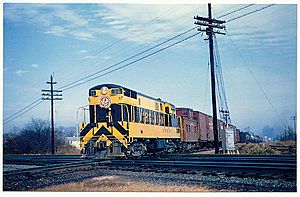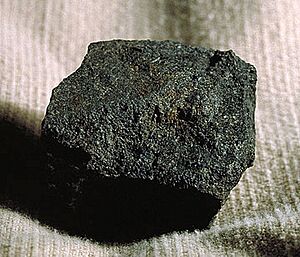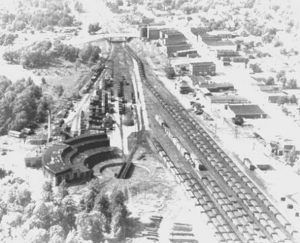Virginian Railway facts for kids
 |
|

VGN 36 Fairbanks-Morse H-16-44 diesel locomotive crossing the diamond with Norfolk & Western Railway at South Norfolk, VA
|
|
| Overview | |
|---|---|
| Headquarters | Norfolk, Virginia |
| Reporting mark | VGN |
| Locale | Deepwater, West Virginia – Norfolk, Virginia |
| Dates of operation | 1907–1959 |
| Successor | Norfolk and Western |
| Technical | |
| Track gauge | 4 ft 8 1⁄2 in (1,435 mm) standard gauge |
The Virginian Railway (VGN) was a major railroad in the United States. It operated in Virginia and West Virginia. The main goal of the VGN was to transport high-quality "smokeless" bituminous coal. This coal came from southern West Virginia and was shipped to the port at Hampton Roads.
Contents
The Virginian Railway Story

In the early 1900s, a civil engineer named William Nelson Page teamed up with a rich businessman, Henry Huttleston Rogers. Rogers was one of the wealthiest people in the world. They wanted to build a railroad to reach new coal areas in West Virginia.
Page first started the Deepwater Railway. It was a smaller railroad, about 85 miles long. But other big railroads tried to stop him. They wouldn't let him easily transfer coal to their lines. Page didn't give up! With Rogers' help, they secretly started another railroad in Virginia, called the Tidewater Railway. This allowed them to build tracks all the way to Hampton Roads. There, they built a new pier just for loading coal onto ships.
In 1907, the two projects officially joined. They became the Virginian Railway. They built this "Mountains to Sea" railroad even though the big railroad companies tried to block them. Henry Rogers paid for most of it with his own money. The Virginian Railway was very modern. It had new tracks and equipment. This made it more efficient than its older, larger competitors.
For 50 years, the VGN was very successful. It was known for using the biggest and best steam, electric, and diesel engines. People even called it "Richest Little Railroad in the World." In 1959, it joined with the Norfolk and Western Railway. Today, much of the old VGN line is still used by the Norfolk Southern Railway.
Building the "Conveyor Belt on Rails"
The Virginian Railway (VGN) was like a "conveyor belt on rails." It was designed to move high-quality coal from West Virginia to the ports in Virginia. Unlike other railroads that curved a lot, the VGN was built as straight and flat as possible. This made it very efficient for carrying heavy coal trains.
The Visionaries: Page and Rogers
William Nelson Page (1854–1932) was a smart civil engineer and businessman. He came to West Virginia in the 1870s to help build other railroads. Page became very successful in developing West Virginia's rich coal fields. He also built railroads to move the coal. People called him "The idea man from Ansted."
Henry Huttleston Rogers (1840–1909) was a very wealthy industrialist. He started working young and saved his money. He helped develop oil and natural gas in Pennsylvania. Rogers became a key person in Standard Oil and was one of the richest men in the U.S. He was also involved in many railroad projects.
Page knew about lots of untouched coal in West Virginia. This coal was in areas not yet reached by the big railroads like C&O and N&W. Page planned to use these coal lands. Rogers and other investors joined him. This created a powerful team.
Two Railroads Become One
At first, Page and Rogers planned a smaller railroad called the Deepwater Railway. It was only meant to be in West Virginia. But when they couldn't easily connect with the bigger railroads, they extended the Deepwater's path. It reached the Virginia state line. Key towns on the Deepwater Railway were Page, Mullens, and Princeton.
In Virginia, they started another railroad, the Tidewater Railway. This line went across southern Virginia to Hampton Roads. Important stops included Roanoke, Victoria, Suffolk, and Sewell's Point. A new coal pier was built at Sewell's Point.
Victoria: A New Railroad Town
In late 1906, a new town was created in Virginia. It was about halfway along the Tidewater Railway. This town was named Victoria, after Queen Victoria of the United Kingdom. Henry Rogers admired her.
Victoria became a major center for the VGN. It had a large area for fixing train engines. There was a roundhouse, a turntable, and places to get coal and water for steam locomotives. The VGN's offices for its Norfolk Division were also built there.
The Virginian Railway is Born
The Virginian Railway Company was officially formed on March 8, 1907. It combined the Deepwater Railway and the Tidewater Railway into one big railroad. William Nelson Page became its first president.
Building the VGN continued through 1907 and 1908. They used new building methods that weren't available when older railroads were built. Henry Rogers paid for the work with his own money. This meant the railway was built without any public debt. This was a huge achievement!
Rogers faced some money problems in 1907. He also had a stroke. But he recovered and made sure the railroad was finished. It was completed in early 1909.
The Last Spike and Celebrations
The very last spike for the Virginian Railway was driven on January 29, 1909. This happened near the big New River Bridge at Glen Lyn, Virginia. This is where the railroad crossed into Virginia from West Virginia.
In April 1909, Henry Rogers and his old friend Mark Twain came to Norfolk, Virginia. They celebrated the completion of the new "Mountains to the Sea" railroad. Rogers then took his first (and only) tour of the new railway. He died suddenly six weeks later. The work of Page and Rogers was complete. They had built a modern, efficient railroad with no debt. It was an amazing accomplishment in U.S. railroading.
Operating the "Richest Little Railroad"
Henry Rogers left behind a wonderful new railroad. It was known for treating its employees and suppliers well. The VGN always aimed for the best efficiency. It experimented with the newest and largest locomotives. This is why it earned the nickname "the richest little railroad in the world."
The VGN had a very steep hill at Clark's Gap in West Virginia. To handle this, they decided to use electricity. Starting in 1922, they added overhead wires for 134 miles of track in the mountains. This section went from Mullens, West Virginia, to Roanoke, Virginia. The VGN even built its own power plant to supply electricity. This huge project was finished in 1925.
In the mid-1950s, the VGN realized that diesel-electric locomotives were becoming more efficient. They also had trouble finding parts for their old steam engines. So, between 1954 and 1957, they bought many new diesel locomotives. The last steam train ran in June 1957.
By the end of 1956, the VGN operated 611 miles of main track and 1089 miles of total track.
Major Stops and Crossings
Here are some of the main stops and crossings along the Virginian Railway's 436-mile main line:
- Deepwater, West Virginia
- Mullens
- Princeton
- Roanoke, crossing Norfolk and Western
- Victoria
- Suffolk, crossing Atlantic Coast Line Railroad and Seaboard Air Line Railroad
- Norfolk
End of Steam and Passenger Service
| Year | Traffic |
|---|---|
| 1925 | 2771 |
| 1933 | 1943 |
| 1944 | 4058 |
| 1956 | 5358 |
After 1957, the Virginian Railway stopped using steam locomotives. Because of this, many of their old maintenance facilities were no longer needed. Places like Page, West Virginia, Mullens, Princeton, Roanoke, Victoria, and Sewell's Point had large roundhouses and shops that became empty.
The VGN also stopped its passenger train service. By 1956, there were no more passenger trains running on the line.
Joining with Norfolk & Western
During World War I, the VGN worked closely with its competitor, the Norfolk & Western Railway (N&W). They found that working together made things much more efficient. After the war, they went back to being competitors. But N&W always remembered how good the VGN's low-grade route was.
For many years, other railroads tried to buy the Virginian Railway. But the U.S. government agency that regulated railroads, the Interstate Commerce Commission, said no. Finally, in 1959, the merger between Norfolk & Western Railway and Virginian Railway was approved.
The Virginian Railway's Lasting Impact
Even after it merged, people still remembered the Virginian Railway. An author named H. Reid wrote a book about it, saying, "There will always be a Virginian."
Today, parts of the VGN's original route are still very important. They are used by Norfolk Southern Railway to move coal to the east. Other parts of the old VGN tracks in eastern Virginia now carry fresh water. They are also being studied for future high-speed passenger trains. The land at Sewell's Point, where the VGN had its coal pier, is now part of the U.S. Naval Station, Norfolk.
Even though it's a "fallen flag" railroad (meaning it no longer exists on its own), the Virginian Railway still has many fans. These include former employees, model builders, and historians. Many old VGN passenger stations have been saved. The station in Suffolk is now a museum. The station in Roanoke is also being preserved. The Oak Hill Railroad Depot in West Virginia, the only remaining VGN station there, has also been restored.
Three of the VGN's old locomotives and many cabooses have been saved. One steam engine and one electric engine have been restored. You can see them at the Virginia Museum of Transportation in Roanoke, Virginia.
In 2012, Norfolk Southern Railway honored the Virginian Railway. They painted one of their new locomotives, NS #1069, in the VGN's original yellow and black colors. This was to celebrate the history of the Virginian Railway.
Museums and Stations to Visit
- Oak Hill, West Virginia - A restored VGN freight station.
- Mullens, West Virginia - Home to the VGN Caboose 307 Museum.
- Princeton, West Virginia - A replica station and museum.
- Roanoke, Virginia - The Virginia Museum of Transportation has two VGN locomotives and a restored VGN freight station.
- Roanoke, Virginia - Plans are underway to preserve the VGN Passenger Station and create a future museum.
- Victoria, Virginia - You can see a fully restored VGN caboose (No. 342) and a museum here.
- Suffolk, Virginia - A restored station that was used by both Seaboard and VGN, now a museum.
Heritage Locomotive
As part of its 30th anniversary in 2012, Norfolk Southern painted 20 new locomotives in the colors of old railroads. NS #1069, an EMD SD70ACe locomotive, was painted in the Virginian Railway's classic yellow and black design.





